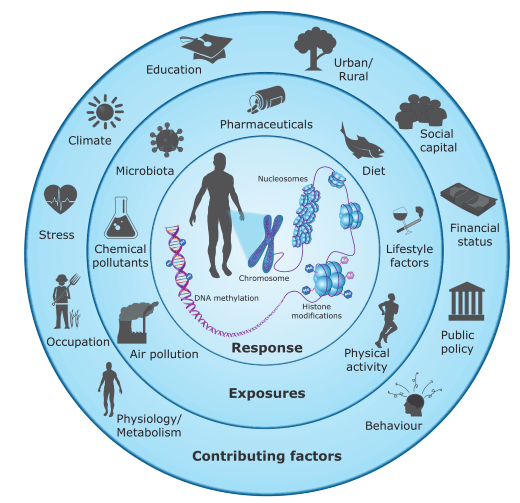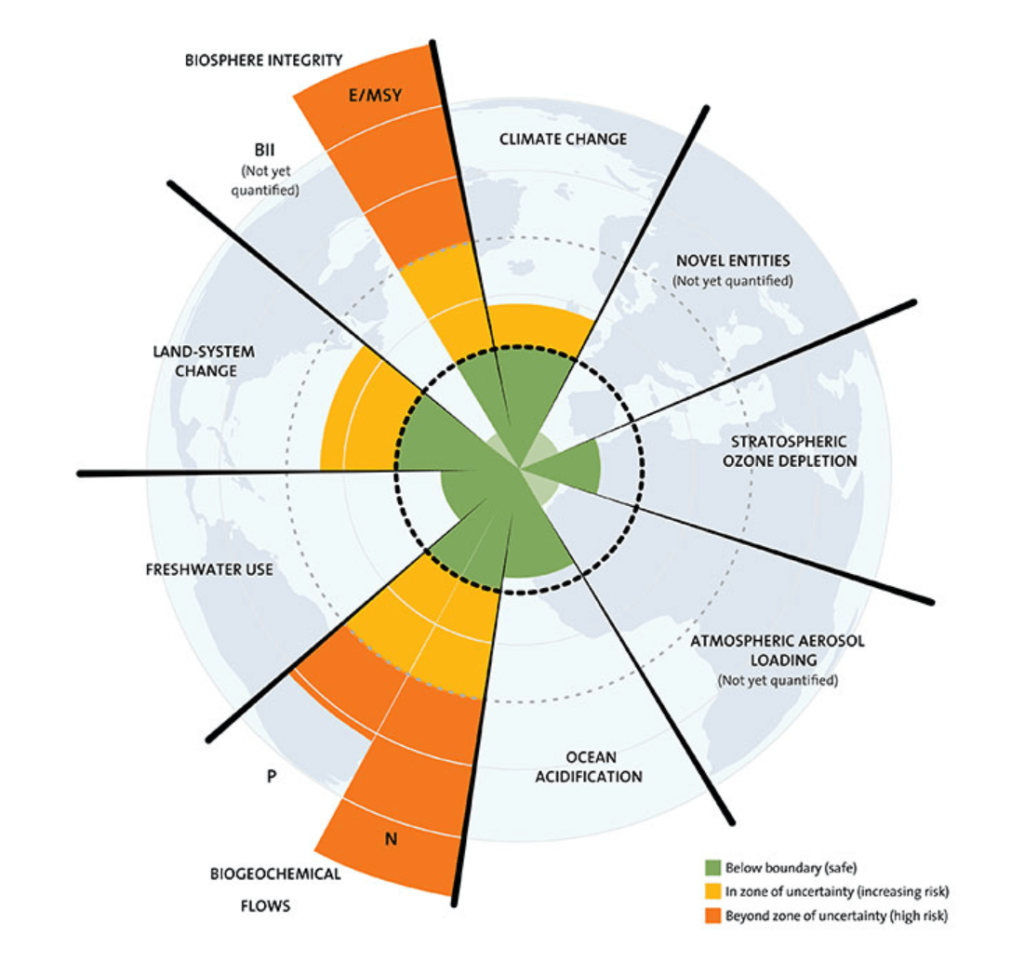In the last 30 years, the relationships, ties and threads between private interests and the state have become more tightly interwoven. This has occured through industry alliances, via lobbying and corporate mergers, and impacted the executive (administrative) and legislative (Parliament) arms of democratic governments to then shape governance cultures. The increasingly rapid pace of private-public networking and policy development has been assisted by increasingly sophisticated communications technologies.
The same relationships, ties and threads between the public and the state have not been similarly nurtured. The effect is that economic growth has become the effective backbone of modern democracies, and it is now extraordinarily difficult for public servants to make decisions that are inconsistent with business activities.
However over this period release of new technologies and pollution have escalated, relatively unchecked, with economic activity and population growth. Unchecked – because the the institutional mechanisms, the regulatory teeth, institutional checks and balances, have eroded to such an extent that new technologies and pollution is uncontrolled in most nations. Stewardship is absent, is performed, or lags profoundly behind the evidence of risk that is documented in the scientific literature.
What has happened?
Large institutional and industry alliances have formed and consolidated. Mergers have escalated transnational power. Previously disparate institutions have consolidated under large institutional investors.
Government policy has shifted to position universities and research centres as drivers of economic activity, predominantly through the production of IP. Policy has directly encouraged private/public research partnerships. Relationships between private institutions and our universities and research institutions have resulted in financial income to these institutions.
The space where research might be undertaken to evaluate the public good of new technologies has eroded. Financial conflicts of interest have resulted in a chilling effect in public institutions, where critical work is less likely to be undertaken. The agency of the university is reduced.

Universities as critic and conscience of society – in a capacity that might enable universities to critically draw attention to the production of novel technologies and their potential to contribute to human and environmental health harms – has dissolved. However, universities and government institutions have maintained their critic and conscience role regarding the behaviour of citizens, and their personal responsibility for wicked problems such as climate change, obesity, and the health of babies and children.
Policy has policy has shifted to urge citizens to personally manage their risk, and take responsibility for behaviour through behaviour change (such as dietary, purchase patterns, waste managment).
Regulatory authorities have increased their dependence on income from the regulated industries to justify and support continued institutional work. Over time, the industry being regulated, and regulators develop relationships and regulatory actions alter to support service actions. The capacity of regulatory institutions to adopt new practices and technological approaches which might challenge their ‘service’ orientation, are less likely to be adopted as relationships between the regulator and the regulated produce a chilling effect on proactive activity. The agency of the regulator is reduced.
As research institutions shift away from critical scientific and technological research that might explore drivers of environmental and human health harm, their capacity to feed into and challenge the regulatory environment becomes eroded.
Relationship management or lobbying occurs through several key channels: Through financial support to political parties; via input to government policy at the local, regional and national level; close relationships with science media institutions; through the development of local and multinational thinktanks; via ongoing relationship management with regulatory institutions; during the development of trade agreements; via quick court action when practices are challenged; via advertising in newspapers and media (which creates a chilling effect on critical media; and through the monitoring and quick response to newsworthy issues in the media. The agency of the media is reduced.
These practices equate to the perpetuation of asymmetrical power – effective entrapment by the private sector. During this 3-decade period, management and release of technologies and pollution has effectively uncontrolled. – and this has led to scientists recognising technologies and their uncontrolled releases currently present an existential risk to humanity.
The sustained release of anthropogenic emissions, including pollution and new technologies now threatens humanities safe operating space – recognised as the 9 planetary boundaries.
The release of carbon dioxide into the atmosphere is part of the uncontrolled release of technologies and pollution.
Citizens have been predominantly unable to contest this power, as they lack the resourcing, or similarly matched institutional power that would enable private institutions to contest challenges to their activities. This is not surprising – the advance of technology and the accumulation of power is inevitable, and institutions will continue to seek to secure power and delay, diffuse and discredit uncomfortable knowledges which might threaten their political or financial power.This is the historic ‘church and state’ dilemma – and separation of ‘church’ in this case societies knowledge building functions, must be separated from the economic activity of state.
What can civil society do?
Advance knowledge and expertise across civil society, and across the machinery of government, that assist decision-makers to make decisions in moments of uncertainty and ambiguity.
‘The precautionary principle provides justification for public policy and other actions in situations of scientific complexity, uncertainty and ignorance, where there may be a need to act in order to avoid, or reduce, potentially serious or irreversible threats to health and/or the environment, using an appropriate strength of scientific evidence, and taking into account the pros and cons of action and inaction and their distribution.’
EEA 2013
Develop constitutional protections that ensure that the executive, legislative and judiciary do not work in concert but rather, act as effective checks and balances to restrict state actions that have potential to impair state capacity to protect human and environmental health.
Invest in the education of public servants and elected members in the principles of constitutional and administrative law, so that they recognise their overriding obligation to protect the public interest.
Establishment of separate health and environmental research institutions with block funding to conduct interdisciplinary research wicked problems, including pollution, obesity and risk from novel technologies.
Implement the precautionary principle across the machinery of government, and advance education to facilitate the appropriate judgement of risk in uncertain and ambiguous environments to prioritise the protection of human and environmental health for future generations.
Prioritise protection of future generations. Adjust policy (and scientific research) to place protection of vulnerable developmental stages (from conception through childhood and adolescence) at the centre of decision-making and recognise the potential for overlapping factors to drive harm including neurodevelopmental, reproductive, and inflammatory.
Prioritise protection of drinking water. Adjust policy to place protection of groundwater and drinking water at the centre of decision-making, and recognise the potential for overlapping factors to drive harm including economic activity, urban activity from diffuse and source point emissions
Pass laws to protect press freedom. The media are vulnerable to influences of funding directed towards them from private and public interests. Ensure that laws constitutionally protect media expression/freedom at a high level, and ensure that government has the obligation to promote diverse expression in the media and in public debate.
References
Bostrom , N. (2013). Existential Risk Prevention as Global Priority Global Policy 4, 1. doi: 10.1111/1758-5899.12002
EEA 2013. Late lessons from early warnings: science, precaution, innovation. Report No. 1/2013. doi:10.2800/73322
EPRS | European Parliamentary Research Service (2014). The Precautionary Principle. Definitions, Applications and Governance. December 2015 — PE 573.876. https://www.europarl.europa.eu/RegData/etudes/IDAN/2015/573876/EPRS_IDA(2015)573876_EN.pdf
Grayling, A.C. (2017). Democracy and its Crisis. Oneworld Publications
Karlsson, O., Rocklov, J., Lehoux, A., Bergquist, J., Rutgersson, A., Blunt, M., & Birnbaum, L. (2020). The human exposome and health in the Anthropocene. International Journal of Epidemiology, 1-12. doi: 10.1093/ije/dyaa231
Ord T. The Precipice. Bloomsbury Publishing. 2020.
Palmer, G. & Butler A. (2018). Towards Democratic Renewal. Victoria University Press.
Renn 2015. Stakeholder and Public Involvement in Risk Governance. Int J Disaster Risk Sci 6:8–20. DOI 10.1007/s13753-015-0037-6
Scott D. Application of the Precautionary Principle During Consenting Processes in New Zealand: Addressing Past Errors, Obtaining a Normative Fix and Developing a Structured and Operationalised Approach (LLM Thesis, Victoria University of Wellington, 2016).
Steffen, W., Richardson, K., Rockstrom, J., Cornell, S. E., Fetzer, I., Bennett, E. M., . . . Persson, L. M. (2015). Planetary boundaries: Guiding human development on a changing planet. Science, Science Express doi: 10.1126/science.1259855
Steffen W. et al. (2018). Trajectories of the Earth System in the Anthropocene. PNAS 115, 33, 8252-8259. www.pnas.org/cgi/doi/10.1073/pnas.1810141115
Annual Report of the Government Chief Scientific Adviser 2014. (2014) Innovation: Managing Risk, not Avoiding it. https://www.fhi.ox.ac.uk/wp-content/uploads/Managing-existential-risks-from-Emerging-Technologies.pdf
